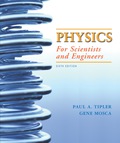
Concept explainers
(a)
The expression for the charge
(a)
Answer to Problem 57P
The expression for the charge
Explanation of Solution
Given Data:
The radius of a spherical shell is
The thickness of spherical shell is
Formula used:
The expression for the charge
Here,
Calculation:
The expression for the charge
Conclusion:
Therefore, the expression for the charge
(b)
The expression for the potential
(b)
Answer to Problem 57P
The expression for the potential
Explanation of Solution
Formula used:
The expression for the potential in the interval of
Calculation:
The expression for the potential is calculated as,
Conclusion:
Therefore, the expression for the potential
(c)
The potential at
(c)
Answer to Problem 57P
The potential at
Explanation of Solution
Formula used:
The expression for the potential
Calculation:
Integrate the above expression in the interval of
Conclusion:
Therefore, the potential at
(d)
The expression for the potential
(d)
Answer to Problem 57P
The expression for the potential
Explanation of Solution
Formula used:
The expression for the potential at radius
Calculation:
The potential at radius
The value of
Substitute the value of
Conclusion:
Therefore, the expression for the potential
(e)
The potential at
(e)
Answer to Problem 57P
The potential at
Explanation of Solution
Formula used:
The expression for the potential
Calculation:
Integrate the above expression from
Conclusion:
Therefore, the potential at
(f)
The total potential
(f)
Answer to Problem 57P
The total potential
Explanation of Solution
Formula used:
The expression for the potential at
The expression for the potential at
Calculation:
The total potential
Conclusion:
Therefore, the total potential
Want to see more full solutions like this?
Chapter 23 Solutions
Physics for Scientists and Engineers
- A capacitor with a capacitance of C = 5.95×10−5 F is charged by connecting it to a 12.5 −V battery. The capacitor is then disconnected from the battery and connected across an inductor with an inductance of L = 1.55 H . At the time 2.35×10−2 s after the connection to the inductor is made, what is the current in the inductor? At that time, how much electrical energy is stored in the inductor?arrow_forwardCan someone help me with this question. Thanks.arrow_forwardCan someone help me with this question. Thanks.arrow_forward
 Physics for Scientists and Engineers: Foundations...PhysicsISBN:9781133939146Author:Katz, Debora M.Publisher:Cengage Learning
Physics for Scientists and Engineers: Foundations...PhysicsISBN:9781133939146Author:Katz, Debora M.Publisher:Cengage Learning Physics for Scientists and Engineers with Modern ...PhysicsISBN:9781337553292Author:Raymond A. Serway, John W. JewettPublisher:Cengage Learning
Physics for Scientists and Engineers with Modern ...PhysicsISBN:9781337553292Author:Raymond A. Serway, John W. JewettPublisher:Cengage Learning Physics for Scientists and Engineers, Technology ...PhysicsISBN:9781305116399Author:Raymond A. Serway, John W. JewettPublisher:Cengage Learning
Physics for Scientists and Engineers, Technology ...PhysicsISBN:9781305116399Author:Raymond A. Serway, John W. JewettPublisher:Cengage Learning Principles of Physics: A Calculus-Based TextPhysicsISBN:9781133104261Author:Raymond A. Serway, John W. JewettPublisher:Cengage Learning
Principles of Physics: A Calculus-Based TextPhysicsISBN:9781133104261Author:Raymond A. Serway, John W. JewettPublisher:Cengage Learning Physics for Scientists and EngineersPhysicsISBN:9781337553278Author:Raymond A. Serway, John W. JewettPublisher:Cengage Learning
Physics for Scientists and EngineersPhysicsISBN:9781337553278Author:Raymond A. Serway, John W. JewettPublisher:Cengage Learning





